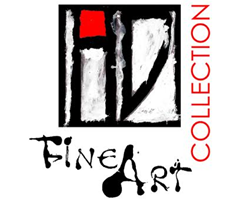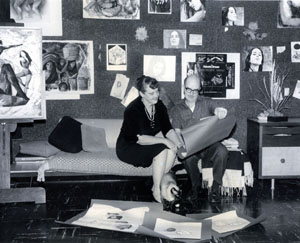Product Description
Duval Eliot “Still life”, Oil on canvas, wood frame c. 1945


DUVAL ELIOT (1909-1990) USA
Still life c. 1945
Oil on canvas, wood frame
Signed: Duval Eliot (lower right)
Painting H: 30” x W: 24”
Frame H: 38” x W: 32”
Duval Eliot, nee’ Ruby Duval Bearden, was born in Arkansas, and at a young age moved with her family to California. After going to Hollywood High School, she attended The Los Angeles Trade Technical College (then known as Frank Wiggins Trade School), studying Commercial Art and Design. While there, she began her art career as a men’s fashion illustrator. Then, because of her immense interest in art, immediately enrolled in Art Center School in Los Angeles, being one of their first students. She studied landscape painting (watercolor and oil), portrait, life drawing and illustration with Barse Miller and with Joseph Henniger, life drawing. At Art Center she continued studying all facets of commercial art and simultaneously worked at the Columbia Advertising Agency designing newspaper layouts and fashion illustrations for the major Los Angeles department stores such as I. Magnin, The Broadway, I. Miller, Wetherby Kayser, and Sak’s in Beverly Hills.
Throughout the 1940’s, Duval continued to create watercolor landscapes of Southern California and the West, while illustrating for J.J. Hagarty. Commercially, her prime focus was free-lance illustration, which could be created with a young child in tow, finding interesting work at the “Western Family Magazine,” for whom she did illustrations for over ten years. She also illustrated children’s storybooks and textbooks for MacMillian and L.W. Stinger publishing houses, meanwhile creating Fashion Advertisements and billboards in full color for Phelps & Terkel for several years and billboards for Silverwoods Department Store. For this work, Duval received the Western Art Directors Award in 1946.
During the post World War II years, Duval honed her fine art techniques. She studied with such notable artists as: Barse Miller, Hardy Gramatky and Ejnar Hansen (watercolor) and also with Hansen, (landscape & portrait painting in oil). In 1948, in The Fourth Annual Los Angeles Exhibition at The Greek Theater in Griffith Park, she won 1st Prize for her watercolor entitled “End of the Trail” among her peers of 326 entrants for painting, including Francis De Erdely, Lorser Feitelson, Conrad Buff, James Couper Wright, Frode N. Dann, Joshua Meador, Dan Lutz, and Chas. Payzant. She also studied painting with Conrad Buff, J.C.Wright, Design and Abstract Painting with Leonard Edmonson, and later, painting in acrylic with 2 years of intensive color with Guy MacCoy and silk-screen Serigraphy with Mario De Perentes. Duval also became close friends with Milford Zornes.
Duval became active in “The Southern California Designer Craftsmen” (S.C.D.C.) She won many awards and exhibited extensively throughout the 1950’s and 1960’s at Barnsdall Municipal Art Gallery, Pasadena Art Museum (paintings and enamels}, Gallery 333 on La Cienega. In the 1940s, she turned towards more formal subject matter including landscape and still life and honed her fine art techniques in watercolor, oil, acrylic, and printmaking.
She participated in several group exhibitions in the Los Angeles area in the late 50s and early 60s. Her work was featured in solo exhibitions at the Jack Carr Gallery in Pasadena in 1976 and the Brand Library Gallery in Glendale in 1988.
Duval was also an active member and on the boards of “The Pasadena Society of Artists”, ”The Los Angeles Art Association”, “Women Painters of the West”, as well as S.C.D.C., participating in numerous group (Design 6, 7, 8, and 9 at the Pasadena Art Museum) and one man shows in the vicinities of Pasadena, Glendale, Santa Barbara and Claremont. She was represented in Paris by two silk screen serigraphs at The Exposicion Internacionale des Federacion Femenine at The Museum des Arts Decoratifs in 1971.
Duval Eliot was also represented in The Los Angeles County Art Museum’s show “MADE IN CALIF” in 2001 with “Chavez Ravine” and “3rd St. Traffic”.
Duval Eliot “Still life”, Oil on canvas, wood frame c. 1945
VICTOR ARNAUTOFF (1896-1979) USA
The Felt Hat c. 1930
Oil on canvas, white gold frame
Signed: V. Arnautoff, lower right
Exhibited: Art Center San Francisco, 1931 (see image of the review in the San Francisco Examiner, July 12th, 1931)
For more information see: The New Deal for Artists, Richard D. McKinzie (Princeton, NJ: Princeton University Press, 1973), Coit Tower, San Francisco : Its History and Art
Painting: H: 26” x W: 21”
Framed: H: 32 ½” x 27 ½”
Price: $60,000
Victor Arnautoff created paintings and watercolors, focusing on portraits, still lifes and rural landscapes in his early years, and moved to more socially conscious themes later in his career. Arnautoff was a native of Russia, to which he returned during the 1960s after thirty years in the United States. He came to San Francisco from Russia via China, bringing his wife and children with him, and studied at the California School of Fine Arts studying with Ralph Stackpole and Edgar Walter before going to Mexico. There he worked as an assistant to the famous Mexican muralist Diego Rivera. During the 1930s, Arnautoff worked as project director and one of the artists selected to create the famed Coit Tower murals, he played a key role in determining the political and social content of the frescoes painted in the San Francisco landmark. His own contribution, City Life, appears to be a lively, non-political melding of downtown San Francisco scenes; however, closer study reveals two leftist newspapers on the newsstand, while the city’s most mainstream daily, the San Francisco Chronicle, is strangely missing. Arnautoff also painted frescoes in the Military Chapel at San Francisco’s Presidio, in the Anne Bremer Library of the San Francisco Art Institute, and in high schools and other buildings in the Bay Area. He was a professor of art at Stanford University from 1939 until his retirement in 1963.
